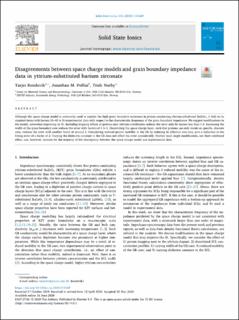| dc.contributor.author | Bondevik, Tarjei | |
| dc.contributor.author | Polfus, Jonathan Marc | |
| dc.contributor.author | Norby, Truls Eivind | |
| dc.date.accessioned | 2020-10-26T11:02:23Z | |
| dc.date.available | 2020-10-26T11:02:23Z | |
| dc.date.created | 2020-06-30T13:37:15Z | |
| dc.date.issued | 2020 | |
| dc.identifier.citation | Solid State Ionics. 2020, 353 . | en_US |
| dc.identifier.issn | 0167-2738 | |
| dc.identifier.uri | https://hdl.handle.net/11250/2684962 | |
| dc.description.abstract | Although the space charge model is commonly used to explain the high grain boundary resistance in proton conducting yttrium-substituted BaZrO3, it fails in its simplest forms with factors 10–40 to fit experimental data with respect to the characteristic frequency of the grain boundary impedance. We suggest modifications to the model, somewhat improving its fit. Including trapping effects of protons near yttrium substituents reduces the error only by factors less than 1.6. Increasing the width of the grain boundary core reduces the error with factors of 1.5–3. Discretizing the space charge layer, such that protons can only reside on specific, discrete sites, reduces the error with another factor of around 2. Considering reduced proton mobility in the GB by reducing its effective area may give a reduction in the fitting error of a factor of 2. Varying the dielectric constant in the GB does not affect the error considerably. Neither each single modification, nor their combined effect, can, however, account for the majority of the discrepancy between the space charge model and experimental data. | en_US |
| dc.language.iso | eng | en_US |
| dc.publisher | Elsevier | en_US |
| dc.subject | Space charge models | en_US |
| dc.subject | Barium zirconate | en_US |
| dc.title | Disagreements between space charge models and grain boundary impedance data in yttrium-substituted barium zirconate | en_US |
| dc.type | Peer reviewed | en_US |
| dc.type | Journal article | en_US |
| dc.description.version | publishedVersion | en_US |
| dc.rights.holder | © 2020 The Authors. Published by Elsevier B.V. This is an open access article under the CC BY license (http://creativecommons.org/licenses/BY/4.0/). | en_US |
| dc.source.pagenumber | 11 | en_US |
| dc.source.volume | 353 | en_US |
| dc.source.journal | Solid State Ionics | en_US |
| dc.identifier.doi | 10.1016/j.ssi.2020.115369 | |
| dc.identifier.cristin | 1817836 | |
| dc.source.articlenumber | 115369 | en_US |
| cristin.ispublished | true | |
| cristin.fulltext | original | |
| cristin.qualitycode | 1 | |
